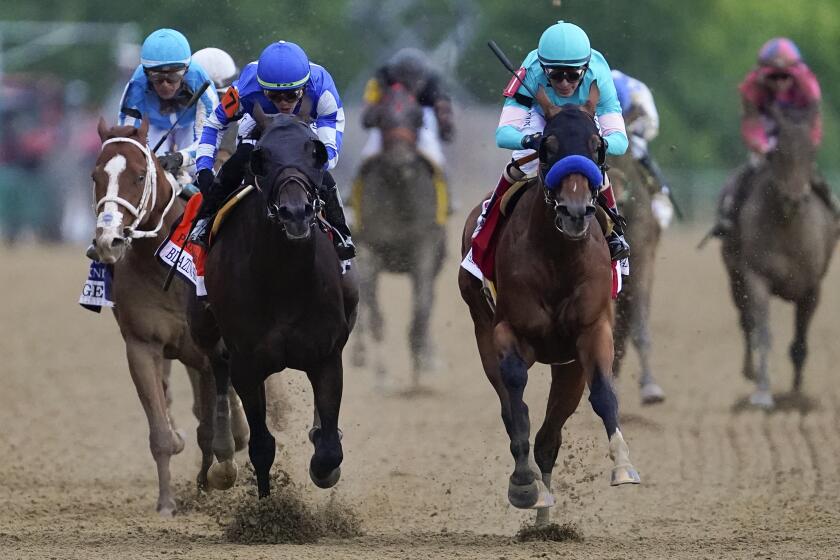Another horse death Saturday at Churchill Downs brings recent toll to 12

- Share via
Less than 24 hours after Churchill Downs had its 11th horse death in less than a month, a 12th horse died on the track in the first race Saturday. Kimberley Dream, a 7-year-old mare running her 61st race, was pulled up in the upper stretch, vanned off the course and euthanized.
Churchill Downs confirmed the death in a statement after racing and stressed a commitment to safety but listed no concrete examples of changes it hopes to make or causes for the spike in fatalities.
“It is with absolute dismay and sorrow that we report this highly unusual statistic,” the statement read in part. “Our team members mourn the loss of these animals as we continue to work together to discover cause and determine appropriate investments to minimize, to the degree possible, any avoidable risk in this sport and on our property. ...
“We have been rigorously working since the opening of the meet to understand what has led to this spike and have yet to find a conclusive [discernible] pattern as we await the findings of ongoing investigations into these injuries and fatalities.”
Kimberley Dream was running in a $40,000 claiming race with only five starters. In her last five races, she lost by 19, 32½, 14½, 31 and 33 lengths. There is no state pre-review panel in Kentucky, like there is in California, to determine whether a horse should be running based on recent performances and other factors.
“Generally speaking [and not specifically about this mare], if a similar horse entered to race in California, those losing distances in the previous races would certainly be a significant concern, raise a red flag and be scrutinized by the entry exam panel that reviews each race card in California,” Dr. Jeff Blea, equine medical director of the California Horse Racing Board, told The Times.
“Many factors are considered and reviewed by the entry panel for each horse entered, including poor performance and running lines in those races. With a horse’s [past performances] showing those poor efforts, if the horse were allowed to run, it would be subject to extra veterinary scrutiny and monitoring from entry day until race time.”
On Friday, Lost in Limbo, a 7-year-old gelding, was euthanized after breaking down in the seventh race. The horse was running in a claiming race, his 35th lifetime start.
Lost in Limbo threw his rider, Ricardo Santana Jr., during the post parade but was OK’d to run.
The number of equine fatalities surpasses that of Santa Anita in 2019. In a similar one-month period, 11 horses died between Dec. 30, 2018, and Jan. 25, 2019. Santa Anita did not close down racing until March 5 after the death toll reached 21 horses. The Churchill Downs meeting is scheduled to go until July 3.
Hours after having to euthanize a horse following an on-track injury, trainer Bob Baffert earned his record eighth Preakness win with National Treasure.
Santa Anita revamped its safety protocols, since adopted by the California Horse Racing Board, and fatalities in the state have decreased by 55% since 2019.
The spate of deaths at Churchill Downs started April 27 when Wild on Ice broke down after a training session and was taken to Lexington for further evaluation. The injury to the Kentucky Derby hopeful was said to be unrecoverable, and he was euthanized. The deaths continued to mount as the week progressed to the Kentucky Derby, with two horses dying on the Derby undercard.
Unlike California and New York, the Kentucky Horse Racing Commission is not transparent on equine fatalities. New York and California have a continually updated website that is available to the public. In addition, Churchill Downs and other tracks it owns do not allow their fatality counts to be made public by the Equine Injury Database. Churchill Downs submits data and allows it to be part of the national average but keeps its results private. Kentucky track Keeneland makes its statistics public. The EID is a flawed accounting system, as it counts only racing deaths, not those in training or through other means.
After a death on the Preakness undercard, there will be heightened scrutiny from the public as the Triple Crown moves to the Belmont Stakes in New York in two weeks.
More to Read
Go beyond the scoreboard
Get the latest on L.A.'s teams in the daily Sports Report newsletter.
You may occasionally receive promotional content from the Los Angeles Times.












